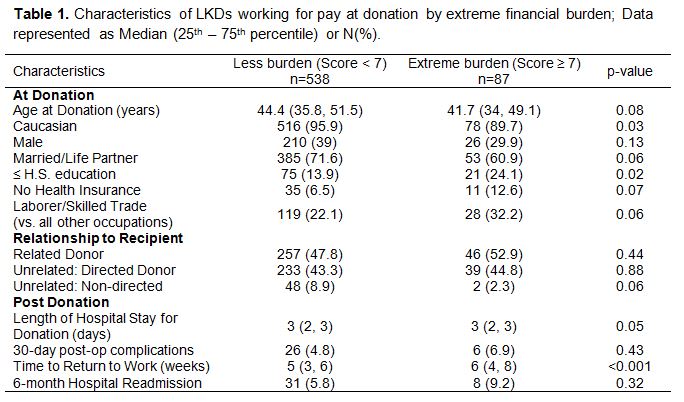Financial Burden and Time to Returning to Work Among Living Kidney Donors.
D. Larson, D. Berglund, D. Vock, A. Roman, J. Wiseman, H. Ibrahim, A. Matas.
U of MN, Mpls
Meeting: 2017 American Transplant Congress
Abstract number: 379
Keywords: Donation, Kidney, Psychosocial
Session Information
Session Name: Concurrent Session: Logistic and Programatic Challenges in Kidney Living Donation
Session Type: Concurrent Session
Date: Monday, May 1, 2017
Session Time: 4:30pm-6:00pm
 Presentation Time: 5:42pm-5:54pm
Presentation Time: 5:42pm-5:54pm
Location: E450b
Surveying our living kidney donor (LKD) population we learned (and reported) that: a) more than a quarter of our LKDs experienced substantial financial burden due to donation, and b) a similar proportion required > 6 wks of recovery before returning to work. Herein, we studied the overall impact time to return to work had on financial burden.
From 2/2005 to 12/2015, we performed 996 LD nephrectomies of which 856 (86%) were working for pay at donation. At 6 mos postdonation, LKDs were surveyed about their recovery experience, including financial burden – scored on a Likert scale from 0-10: (0=none; 10=extreme). In addition, they were surveyed about time in wks to fully return to work.
In total, 625 (73%) LKDs working for pay at donation responded. Average age at donation was 43±11 yrs; 95% White; 62% female; 48% related to their recipient. Of the 625, 87 (14%) reported extreme financial burden from donation (score ≥7 out of 10). Characteristics of those with extreme burden vs. less are shown in the table. Regarding time to return to work: 283 (45%) returned within 1 to 4 wks, 188 (30%) 5 to 6 wks, 119 (19%) 7 to 10 wks, and 30 (5%) >10 wks (n=5 did not answer this question). Average time to return to work was significantly different among donors with extreme (>= 7) financial burden (mean = 6.6 wks; range: 7– 20 wks,) from those with less burden (mean = 5.1 wks), p < 0.001.
After adjusting for donor characteristics, employment type and perioperative outcomes, time to return to work remained a significant predictor of the level of financial burden (increase of 0.78 points on Likert scale/4 week increase in time to employment, p < 0.001). The effect of time (in wks) to return to work on financial burden was moderated by employment type (p = 0.003), with laborers/skilled trade workers experiencing a greater financial burden for each week away from work compared to those employed in other fields.
Conclusion: Time to return to work was significantly associated with greater financial burden, with labored/skilled trade workers experiencing the greatest impact. Donor education should convey this data in order to facilitate adequate financial planning and ensure informed consent.
CITATION INFORMATION: Larson D, Berglund D, Vock D, Roman A, Wiseman J, Ibrahim H, Matas A. Financial Burden and Time to Returning to Work Among Living Kidney Donors. Am J Transplant. 2017;17 (suppl 3).
To cite this abstract in AMA style:
Larson D, Berglund D, Vock D, Roman A, Wiseman J, Ibrahim H, Matas A. Financial Burden and Time to Returning to Work Among Living Kidney Donors. [abstract]. Am J Transplant. 2017; 17 (suppl 3). https://atcmeetingabstracts.com/abstract/financial-burden-and-time-to-returning-to-work-among-living-kidney-donors/. Accessed December 24, 2025.« Back to 2017 American Transplant Congress
